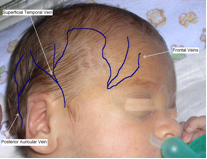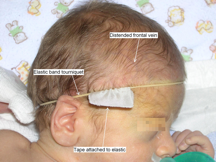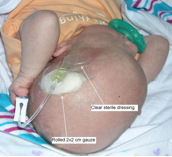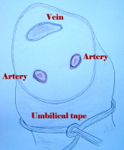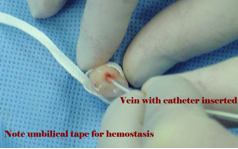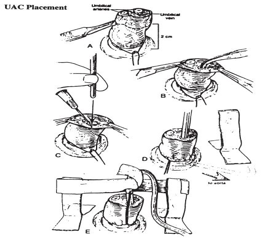Thanks to Dr. Melendez for today’s Morning Report (originally presented on 4/24/2012)!
Venous Access in Neonates
A continuation of my case from 2 weeks ago: A mother brings her 9 day old infant in because “she has not urinated in the past 12 hours and she is very sleepy”. VS: BP70/30, HR 86, RR 35, Trectal: 98.7, O2 sat 100%RA. On exam, the baby appears lethargic, has sunken fontanelles, dry MM without any visualized tears, no evidence of meningismus, bradycardic without appreciable murmur, lungs CTA b/l, abdomen soft without organomegaly or distention, no petechiae or bruising, no cyanosis, poor skin turgor with cap refill >2 secs.
You’ve tried gaining access in the arms and legs but no success. What other options do you have left?
IO, Scalp Vein, Umbilical Vein, Venous Cutdown
Here we will talk about 2 options:
Scalp Vein
Locate the frontal, superficial temporal, or posterior auricular vein in the scalp, as shown in the image below.
- Select a site that is behind the hairline to minimize the risk of leaving a visible scar.
- Shaving the site may be necessary to allow proper visualization and to properly secure the catheter once it has been inserted.
- Place an elastic band around the patient’s head just above the eyes and ears, from forehead to occiput
- Place rolled 2 X 2 cm gauze under the catheter hub to prevent pressure on the underlying skin.
Umbilical Vein
- The umbilical vein may remain patent for about a week after birth (sometimes longer)
- To provide hemostasis and to anchor the line after placement, a loop of umbilical tape or a pursestring 3-0 silk suture is placed at the junction of the skin and the cord and cut with a scalpel about 1 cm from the skin so the vessels are identified.
- The catheter (3.5 Fr [preterm infants] to 5.0 Fr [term infants]), which has been flushed with heparinized saline and attached to a three-way stopcock, is placed in the lumen of the umbilical vein and advanced gently.
- The catheter is advanced only 1 to 2 cm beyond the point at which good blood return is obtained. This is usually only 4 to 5 cm in a term-sized infant.
- If the catheter is pushed farther than this, it may enter the ductus venosus and then move into the inferior vena cava, or it may enter a branch of the portal vein within the liver (evidenced by resistance at 5–10 cm).
- Technical: Correct Position Shoulder-to-umbilicus length is the perpendicular line measured from the tip of the shoulder to the horizontal level of the umbilicus. If the graph is not available, the shoulder-to-umbilicus length multiplied by 0.6 gives an approximate insertion length that will result in the tip of the catheter above the diaphragm but below the right atrium, in the inferior vena cava. Remember to account for the length of the umbilical stump in the calculation.
- Confirm with XR
Great review of how to get access in these difficult neonates! Leave any comments below and thanks for reading.
Jay Khadpe MD
Latest posts by Jay Khadpe MD (see all)
- Morning Report: 7/30/2015 - July 30, 2015
- Morning Report: 7/28/2015 - July 28, 2015
- IN THE STRETCHER INSTEAD OF BESIDE IT - July 22, 2015
- Morning Report: 7/14/2015 - July 14, 2015
- Morning Report: 7/10/2015 - July 10, 2015

